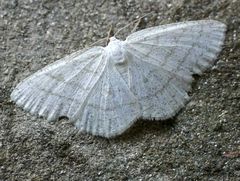Common white wave
Appearance
| Common white wave | |
|---|---|

| |
| Scientific classification | |
| Kingdom: | |
| Phylum: | |
| Class: | |
| Order: | |
| Family: | |
| Genus: | |
| Species: | C. pusaria
|
| Binomial name | |
| Cabera pusaria | |
The common white wave (Cabera pusaria) is a moth of the family Geometridae. It is found throughout the Palearctic region and the Near East.
This species has white wings, sometimes tinged with pink, with three dark fascia on the forewing and two on the hindwing. The wingspan is 32–35 mm. One or two broods are produced each year and the adults can be seen at any time from May to August.[1] This moth flies at night and is attracted to light.
The larva, usually purplish-brown with white spots, feeds on various trees and shrubs including alder, aspen, birch, oak, rowan and willow. The species overwinters as a pupa.
- ^ The flight season refers to the British Isles. This may vary in other parts of the range.
External links
References
- Chinery, Michael Collins Guide to the Insects of Britain and Western Europe 1986 (Reprinted 1991)
- Skinner, Bernard Colour Identification Guide to Moths of the British Isles 1984
